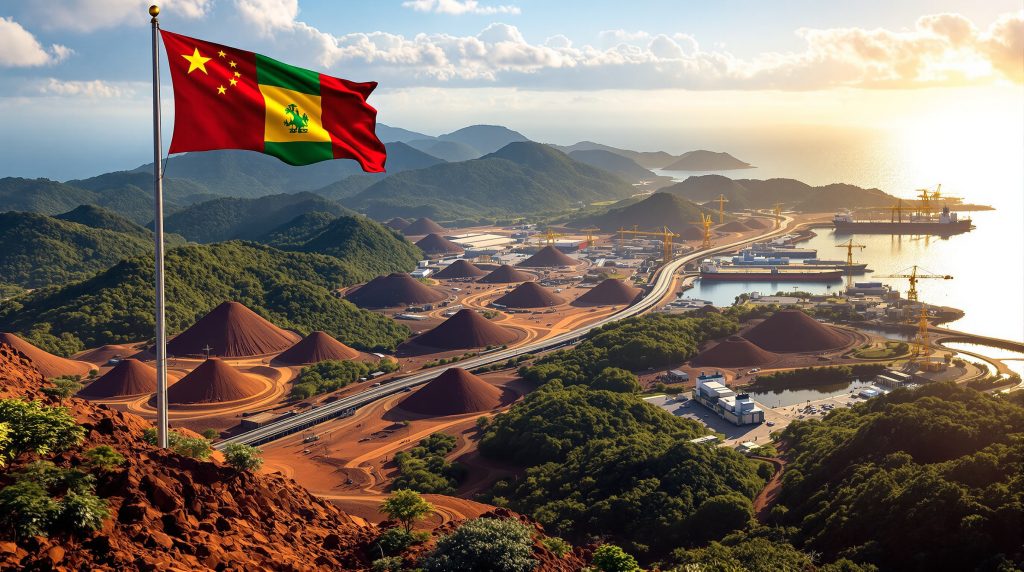What Makes Simandou the Crown Jewel of Global Iron Ore Development?
Understanding the Scale and Strategic Importance
The Simandou project China Africa iron ore development represents one of the most significant mining ventures of the modern era, with the potential to fundamentally reshape global commodity markets. Located in Guinea's remote southeastern mountains, this massive undertaking encompasses what industry experts consider the world's largest undeveloped iron ore deposit, containing an estimated 2.4 billion tonnes of high-grade reserves.
The project's strategic importance extends far beyond its impressive scale. With iron ore grades averaging between 65-67% iron content, Simandou's deposits significantly exceed the global average of 62%, positioning it as a premium supplier in an increasingly quality-conscious steel market. Furthermore, this superior grade means reduced processing requirements and lower transportation costs per unit of usable iron, creating substantial competitive advantages for end users.
The $23 billion infrastructure investment accompanying the mining development creates entirely new trade corridors connecting Guinea's mineral wealth directly to China's industrial demand. This massive capital commitment reflects not just the project's mineral value, but its role as a cornerstone of China's long-term resource security strategy.
The Geographic and Geological Advantage
Nestled in the mountainous terrain of southeastern Guinea's Nzérékoré Region, Simandou presents both exceptional opportunities and formidable challenges. The remote location that initially deterred development now provides strategic advantages in terms of resource control and operational security. The deposit spans four distinct mining blocks across extensive mineral-rich territory, offering decades of potential extraction.
The geological composition consists primarily of high-grade hematite deposits requiring minimal beneficiation compared to lower-grade ores found elsewhere. Consequently, this natural processing advantage translates directly into cost efficiencies and higher profit margins. The deposits' proximity to potential Atlantic shipping routes, once the infrastructure is complete, provides direct access to global markets without the logistical constraints that burden other major iron ore operations.
The equatorial location offers year-round operational capability, avoiding the seasonal disruptions that affect mining operations in more temperate regions. However, the challenging terrain and isolated location necessitated the revolutionary infrastructure approach that has become synonymous with the project's development philosophy.
How Did Chinese Investment Transform Guinea's Mining Landscape?
The Bauxite Foundation Strategy
Sun Xiushun's entry into Guinea during the height of the 2014 Ebola crisis demonstrated a risk appetite that would later prove crucial to Simandou's success. While Western investors evacuated, Sun recognised opportunity in the chaos, establishing the foundational relationships and operational expertise that would eventually unlock the iron ore prize.
His initial bauxite operations served as a proving ground for Chinese engineering capabilities in West African conditions. The development of aluminium supply chains from Guinea to China created a template for resource extraction that emphasised infrastructure-first development and direct end-market integration. This approach differed fundamentally from traditional Western mining models that often relied on third-party logistics and spot market sales.
The bauxite success story provided more than just operational experience. It established crucial trust with Guinean government officials who had witnessed decades of unfulfilled promises from international mining companies. Moreover, Sun's delivery of functional infrastructure within promised timeframes created the political capital necessary for accessing the more valuable iron ore concessions.
The specialised logistics infrastructure developed for bauxite operations became the foundation for the more ambitious iron ore project. Chinese engineering teams gained invaluable experience with Guinea's unique geological conditions, regulatory environment, and labour market dynamics during this preparatory phase.
Infrastructure-First Development Approach
The revolutionary railway construction spanning over 650 kilometres represents a fundamental reimagining of mining project development sequences. Traditional approaches require confirmed reserves, completed feasibility studies, and secured financing before infrastructure development begins. Sun reversed this timeline, betting that functional infrastructure would attract partners and financing rather than the reverse.
Construction of the purpose-built Morebaya port facility demonstrates Chinese adaptability to challenging coastal conditions. The engineering team imported specialised maritime expertise from China's Yantai port to assess tidal patterns, anchorage possibilities, and approach routes. The resulting design accommodates deep-water shipping while managing the logistical complexities of Guinea's Atlantic coastline.
Integration of mining operations with transportation networks created synergies that reduced overall project costs while accelerating development timelines. Rather than treating infrastructure as a necessary expense, the Chinese approach positioned it as a profit-generating asset serving multiple purposes beyond mineral extraction.
In addition, the adaptation of Chinese engineering standards to West African conditions required innovative solutions for tropical climate challenges, local labour integration, and equipment maintenance in remote locations. These adaptations have created a replicable model for resource extraction in similar environments across Africa.
What Role Does China Play in Simandou's Ownership Structure?
Dominant Chinese Consortium Control
The complex ownership structure reflects decades of political manoeuvring and commercial negotiations that transformed Simandou from a Western-dominated prospect to a Chinese-controlled operation:
| Ownership Entity | Stake | Key Companies |
|---|---|---|
| Chinese Consortium | 75% | Winning International, Weiqiao Aluminium, China Baowu Steel |
| Rio Tinto | 25% | Joint venture with Chinalco |
| Guinea Government | Minority stakes | Both northern and southern blocks |
The Chinese consortium's control extends beyond simple equity ownership to encompass operational management, infrastructure development, and market access. Winning International, led by Sun Xiushun, serves as the primary operational entity, while Weiqiao Aluminium and China Baowu Steel provide financial backing and guaranteed off-take agreements.
This ownership structure ensures vertical integration from extraction through steel production, eliminating market volatility risks that traditionally plague mining operations dependent on spot pricing. The guaranteed demand from Chinese steel producers provides revenue stability that justified the massive infrastructure investments.
Strategic Partnership Dynamics
The Winning Consortium Simandou manages the northern blocks (1 & 2), while Rio Tinto maintains influence through its partnership with Chinalco in the southern blocks (3 & 4). This division reflects the historical evolution of the project, with Chinese interests gradually gaining control through strategic acquisitions and government relationships.
Shared railway infrastructure operates through a joint company structure that includes both Chinese and international partners alongside the Guinean government. This arrangement ensures operational coordination while maintaining each party's interests in their respective concession areas.
Government participation in both northern and southern blocks provides Guinea with direct revenue streams beyond traditional royalty and tax arrangements. This ownership stake aligns government interests with operational success, creating incentives for regulatory support and political stability.
Furthermore, the partnership dynamics demonstrate China's pragmatic approach to international resource development, accepting Western partners when beneficial while maintaining strategic control over critical infrastructure and operations.
How Will Simandou Impact Global Iron Ore Markets?
Production Capacity and Market Disruption
The Simandou project China Africa iron ore development's expected annual output of 120 million tonnes at full capacity represents approximately 10% of global seaborne iron ore demand, positioning it amongst the world's largest single mining operations. This volume scale ensures significant market influence regardless of pricing strategies or operational decisions.
The project's high-grade ore commands premium pricing in increasingly quality-conscious steel markets. As global steel producers face mounting pressure to reduce emissions and improve efficiency, Simandou's superior iron content provides competitive advantages that justify premium payments over lower-grade alternatives.
Production commencement creates immediate competitive pressure on established suppliers, particularly Australian Pilbara operations and Brazilian mines that have dominated seaborne markets for decades. The entry of a major new supplier with cost advantages and guaranteed Chinese demand fundamentally alters supply-demand dynamics, affecting iron ore price trends significantly.
The timing of Simandou's market entry coincides with growing global steel demand driven by infrastructure development and green energy transition requirements. This demand growth partially absorbs additional supply while still creating downward pressure on prices for competing suppliers.
Supply Chain Diversification Benefits
Key Market Impact: Simandou's entry reduces China's dependency on traditional suppliers while potentially creating sustained downward pressure on global iron ore pricing through increased competition and supply diversity.
China's steel industry gains access to a dedicated, high-quality supply source that reduces reliance on Australian and Brazilian operations subject to geopolitical tensions and supply disruptions. This diversification enhances supply security while providing negotiating leverage with other suppliers, particularly relevant given recent US tariffs impact on global markets.
The direct integration between Simandou production and Chinese steel mills eliminates intermediary trading relationships that historically added costs and price volatility. Long-term supply contracts provide both mines and mills with revenue predictability that supports operational planning and capital investment.
European and other Asian steel producers gain access to an additional supply source, reducing market concentration risks and providing alternatives during supply disruptions. This increased competition amongst suppliers benefits consumers through improved pricing and service terms.
Quality Advantages for Modern Steelmaking
Premium iron content supports more efficient blast furnace operations, reducing coke consumption and lowering per-tonne production costs for steel manufacturers. These operational efficiencies become increasingly valuable as carbon pricing and environmental regulations intensify globally.
Lower impurity levels in Simandou ore reduce processing complexity and downstream refining costs whilst producing higher-quality steel products. This quality advantage becomes particularly important for specialised steel applications in automotive, construction, and manufacturing sectors.
The ore's characteristics align with global steel industry decarbonisation goals by enabling more efficient production processes that generate fewer emissions per tonne of steel produced. This environmental advantage provides long-term competitive positioning as carbon regulations tighten.
Enhanced productivity for Chinese steel manufacturers strengthens their global competitiveness whilst reducing production costs that can be passed through to downstream industries. This cost advantage supports China's manufacturing sector across multiple industrial applications.
What Economic Transformation Will Guinea Experience?
National Development Through Resource Extraction
Guinea's government revenues from mining royalties and taxes are projected to increase substantially as the Simandou project China Africa iron ore development reaches full production capacity. These revenue streams provide fiscal resources for national development programmes and infrastructure investments beyond the mining sector.
Employment creation spans multiple sectors including direct mining operations, transportation and logistics services, and supporting industries. The project generates thousands of direct jobs whilst creating multiplier effects throughout the regional economy.
Infrastructure development benefits extend far beyond mining-specific requirements. The railway system enables passenger transport and general freight movement, connecting previously isolated regions to national and international markets for the first time.
Integration of remote regions into the national economic framework creates opportunities for agricultural development, small-scale manufacturing, and service industries that previously lacked market access. This economic integration promotes balanced national development beyond resource extraction.
Regional Infrastructure Multiplier Effects
The railway infrastructure serves dual purposes as both mineral transport and general economic development catalyst. Passenger services connect rural communities to urban centres, facilitating labour mobility and access to education and healthcare services.
Port facilities at Morebaya create opportunities for broader West African trade, potentially serving landlocked countries seeking Atlantic access for their exports. This regional gateway function extends economic benefits beyond Guinea's borders whilst generating additional revenue streams.
Skills development and technology transfer to local workforce creates human capital advantages that persist beyond the mine's operational lifetime. However, Chinese engineering and operational expertise transferred to Guinean workers provides a foundation for future industrial development.
Urban development around mining and transport hubs generates construction activity, retail opportunities, and service sector growth that diversifies the regional economy beyond resource dependence. These secondary effects create sustainable economic activity that continues independently of mining operations.
What Challenges and Controversies Surround the Project?
Environmental and Social Impact Concerns
Disruption to local fishing communities and traditional livelihoods represents one of the most significant social challenges accompanying the project's development. Coastal communities dependent on marine resources face potential impacts from port construction and increased shipping activity.
Environmental monitoring for soil and water quality protection requires ongoing attention as mining operations expand. The tropical climate and heavy rainfall patterns create particular challenges for containing mining waste and preventing contamination of local water sources.
Biodiversity conservation in equatorial forest ecosystems faces pressure from mining infrastructure and associated development. The region's rich ecological diversity requires careful management to minimise habitat destruction and species displacement.
Community displacement and compensation frameworks remain contentious issues requiring ongoing negotiation between project operators, government officials, and affected populations. Fair compensation mechanisms must balance development benefits with individual and community losses.
Safety and Operational Standards
Worker safety incidents during rapid construction phases have drawn criticism from labour advocates and international monitoring organisations. The pressure to maintain aggressive development timelines has sometimes conflicted with comprehensive safety protocol implementation.
Implementation of international safety protocols and training programmes requires ongoing investment and management attention. Adapting global best practices to local conditions whilst maintaining Chinese construction speeds presents ongoing operational challenges.
Balancing construction speed with comprehensive safety measures reflects broader tensions between commercial pressures and worker protection. For instance, the project's high-profile status intensifies scrutiny of safety performance relative to industry standards.
Government oversight of mining and infrastructure operations must evolve to address the scale and complexity of Simandou's operations. Regulatory capacity building ensures appropriate supervision without hindering operational efficiency.
How Does Simandou Fit China's African Investment Strategy?
Belt and Road Initiative Alignment
The project serves as a demonstration of Chinese infrastructure capabilities in challenging African environments, showcasing engineering expertise and project management skills that support broader Belt and Road Initiative objectives. Success at Simandou validates China's approach to African development partnerships, similar to the Zijin Mining expansion strategy across Africa.
Strategic resource security for China's industrial base becomes increasingly important amid global trade tensions and supply chain disruptions. Simandou provides guaranteed access to critical raw materials whilst reducing dependence on potentially unstable supply relationships.
Diplomatic influence through major development partnerships enhances China's soft power in Africa whilst creating precedents for future resource development agreements. The project's success encourages other African nations to consider similar partnerships with Chinese investors.
Economic integration between Chinese and African markets deepens through direct supply chain connections that benefit both regions. This integration creates mutual dependencies that support long-term diplomatic relationships and commercial cooperation.
Geopolitical Implications in Resource Competition
Strategic Context: The project represents China's commitment to African partnerships during a period of heightened global trade tensions, showcasing alternative development models to Western approaches whilst securing critical resource access.
Competition with Western mining companies and development models demonstrates China's alternative approach to African resource partnerships. The success of Chinese-led development challenges traditional assumptions about mining project financing and execution, reflecting broader mining industry evolution patterns.
Resource diplomacy through infrastructure investment creates lasting relationships that extend beyond individual projects. Guinea's partnership with China on Simandou influences broader regional attitudes toward Chinese versus Western development approaches.
Supply chain security considerations become increasingly important as global trade relationships face political pressures. Consequently, Simandou provides China with alternatives to traditional suppliers whilst demonstrating commitment to African development partnerships.
What Timeline and Milestones Define Project Development?
Historical Development Phases
The project's development history spans multiple decades of political changes, ownership transfers, and false starts that illustrate the complexity of major African mining ventures:
- 1990s: Initial Rio Tinto exploration licences established the deposit's commercial potential
- 2008: Government seizure and redistribution of mining rights reflected political dissatisfaction with development pace
- 2019: Chinese consortium acquisition of northern blocks marked the turning point toward rapid development
- 2021: Joint development agreement and infrastructure acceleration phase began
Each phase reflected changing political priorities, evolving commercial relationships, and lessons learned from previous development attempts. The Chinese consortium's approach built upon decades of previous exploration and planning whilst fundamentally altering the development timeline.
Current Production and Future Expansion
November 2025 marked the commencement of first iron ore shipments, representing the culmination of years of infrastructure development and operational preparation. This milestone validates the Chinese approach to mining project development whilst establishing Simandou as a functioning commercial operation.
Phased production ramp-up over subsequent years will gradually increase output toward full capacity targets. This measured approach balances market absorption capacity with operational optimisation requirements whilst managing infrastructure utilisation efficiently.
Full capacity operations targeted for the late 2020s will establish the Simandou project China Africa iron ore development as one of the world's largest iron ore suppliers. Achieving this production level requires continued infrastructure optimisation and workforce development alongside market demand growth.
Ongoing infrastructure optimisation and expansion planning prepare for potential future capacity increases beyond initial targets. The scalable infrastructure design allows for production growth if market conditions and resource development justify additional investment.
How Will Simandou Reshape Iron Ore Investment Strategies?
Market Positioning and Competitive Dynamics
Premium pricing potential for high-grade ore products creates differentiated market positioning that supports higher margins relative to standard-grade competitors. This quality premium becomes increasingly valuable as steel producers optimise for efficiency and environmental performance, supporting iron ore demand insights across global markets.
Long-term supply contracts with Chinese steel producers provide revenue stability that supports project financing and operational planning. These guaranteed sales agreements reduce market risk whilst ensuring demand absorption for planned production volumes.
Impact on commodity-focused investment funds and strategies requires portfolio rebalancing as Simandou's market entry affects relative valuations of competing mining operations. Investors must reassess exposure to higher-cost, lower-grade operations facing increased competition.
Influence on global mining company expansion decisions extends beyond iron ore to other commodities where Chinese infrastructure-first development models might prove applicable. Simandou's success validates alternative approaches to mining project development and financing.
Future Market Evolution
Anticipated surplus in seaborne iron ore markets results from Simandou's production addition combined with existing supplier capacity expansion. This increased supply availability benefits steel producers whilst pressuring higher-cost mining operations.
Pressure on higher-cost, lower-grade mining operations intensifies as quality-conscious buyers shift toward premium suppliers offering better value propositions. Marginal operations face potential closure or conversion to speciality products.
Opportunities for value-added processing and beneficiation increase as miners seek to differentiate their products in increasingly competitive markets. Processing investments that improve ore quality or reduce customer costs become more attractive.
Integration with global steel industry decarbonisation trends creates additional market opportunities for high-efficiency ores that support reduced-emission steel production. Environmental advantages become increasingly valuable competitive differentiators.
Investment Disclaimer: This analysis contains forward-looking statements about commodity markets, project development timelines, and geopolitical relationships that involve inherent uncertainties and risks. Actual outcomes may differ materially from projections due to market volatility, political changes, operational challenges, or other unforeseen factors. Readers should conduct independent research and consult qualified advisors before making investment decisions related to iron ore markets, African mining operations, or Chinese development projects.
Further Exploration:
Readers interested in learning more about major African mining developments and China's resource investment strategies can explore additional educational content covering similar large-scale infrastructure projects and their global market implications.
Ready to Capitalise on the Next Major Mineral Discovery?
Whilst Simandou demonstrates how transformative discoveries can reshape entire commodity markets, Discovery Alert's proprietary Discovery IQ model delivers real-time alerts on significant ASX mineral discoveries, instantly turning complex announcements into actionable investment insights. Explore why historic mineral discoveries can generate exceptional returns and begin your 30-day free trial today to position yourself ahead of the market.




